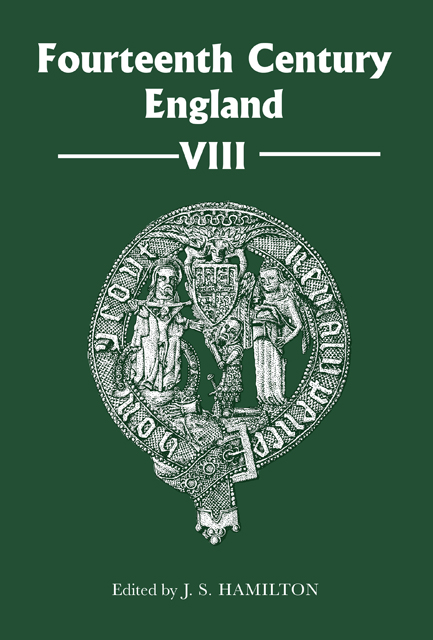Book contents
- Frontmatter
- Contents
- Contributors
- Preface
- Abbreviations
- King's Armourers and the Growth of the Armourer's Craft in Early Fourteenth-Century London
- In the Best Interest of the Queen: Isabella of France, Edward II and the Image of a Functional Relationship
- The First Entry of the Bishop: Episcopal Adventus in Fourteenth-Century England
- Temporalities Be Taken: Edward III, Unruly Ecclesiastics and the Fight for the Benefices of Exeter, 1337–60
- The Armour of Sir Robert Salle: An Indication of Social Status?
- Richard II, the Mortimer Inheritance and the March of Wales, 1381–84
- War, Chivalry and Regional Society: East Anglia's Warrior Gentry before the Court of Chivalry
- A ‘Sterre of þe See to ȝyue Lyȝt to Men’ and ‘Myrroure to Alle Sinful’: A Comparative Analysis of Biblical Women in the English Wycliffite Sermons with John Mirk’s Festial
- Index
- Fourteenth Century England issn 1471–3020
The Armour of Sir Robert Salle: An Indication of Social Status?
Published online by Cambridge University Press: 15 February 2023
- Frontmatter
- Contents
- Contributors
- Preface
- Abbreviations
- King's Armourers and the Growth of the Armourer's Craft in Early Fourteenth-Century London
- In the Best Interest of the Queen: Isabella of France, Edward II and the Image of a Functional Relationship
- The First Entry of the Bishop: Episcopal Adventus in Fourteenth-Century England
- Temporalities Be Taken: Edward III, Unruly Ecclesiastics and the Fight for the Benefices of Exeter, 1337–60
- The Armour of Sir Robert Salle: An Indication of Social Status?
- Richard II, the Mortimer Inheritance and the March of Wales, 1381–84
- War, Chivalry and Regional Society: East Anglia's Warrior Gentry before the Court of Chivalry
- A ‘Sterre of þe See to ȝyue Lyȝt to Men’ and ‘Myrroure to Alle Sinful’: A Comparative Analysis of Biblical Women in the English Wycliffite Sermons with John Mirk’s Festial
- Index
- Fourteenth Century England issn 1471–3020
Summary
The chronicles of Jean Froissart state that during the Peasants’ Revolt of 1381, Sir Robert Salle was in his native Norfolk; that the rebels reminded him he was the son of a villein, a mason; that they appealed to him to be their leader; that he refused, offering instead armed combat; that losing his footing in his stirrups he abandoned his horse and faced the large mob alone. Not surprisingly, he was hacked to pieces. According to Froissart, Salle was wearing his armour on that fateful day and while the vast numbers said to have been involved in the incident can be considered a little fanciful, the claim that Salle possessed armour is not. Contemporary documentary evidence confirms that he owned armour, or a harness, of excellent quality, even though there is no indication as to how he acquired it. Salle lived in an age when there were attempts to regulate a person’s dress and accoutrements in accordance with their wealth and social status. Yet he was merely the son of a villein – a bondman – who by accepted norms should never have been wearing armour. In order to comprehend fully the significance of such a circumstance, this paper will examine the inventory of Salle’s harness and his career in the royal household within the context of the fourteenth-century sumptuary legislation and the related parliamentary petitions, which sought to restrict the wearing of fine apparel. Sumptuary legislation of the following century, which cited specific exemptions and enhanced social status for members of the king’s household, will then be considered. If Salle’s possession of a fine harness can best be understood through the medium of his career at a time when the circumstance of war offered opportunities to a much wider social spectrum, it can also help us to comprehend the contemporary notion that ‘service was ennobling’. However, in this particular case, it is also possible to suggest that what we are presented with is an early instance of the concept articulated in the fifteenth century that royal service brought with it an even greater enhancement of social status.
- Type
- Chapter
- Information
- Fourteenth Century England VIII , pp. 83 - 94Publisher: Boydell & BrewerPrint publication year: 2014

